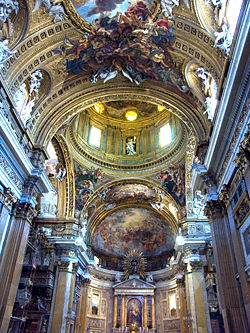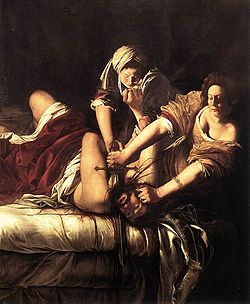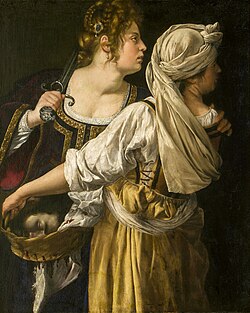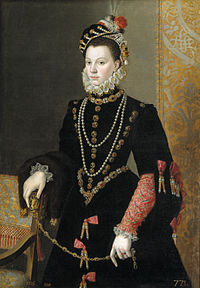
Sofonisba Anguissola was born in Cremona, Lombardy around 1532, the oldest of seven children, six of whom were daughters. Her father, Amilcare Anguissola, was a member of the Genoese minor nobility. Sofonisba's mother, Bianca Ponzone, was also of an affluent family of noble background.
Over four generations, the Anguissola family had a strong connection to ancient Carthaginian history and they named their offspring after the great general Hannibal, thus the first daughter was named after the tragic Carthaginian figure Sophonisba.
Amilcare Anguissola encouraged all of his daughters (Sofonisba, Elena, Lucia, Europa, Minerva and Anna Maria) to cultivate and perfect their talents. Four of the sisters (Elena, Lucia, Europa and Anna Maria) became painters, but Sofonisba was by far the most accomplished and renowned. Elena became a nun (Sofonisba painted a portrait of her) and therefore had to give up painting. Both Anna Maria and Europa gave up art upon marrying, while Lucia Anguissola, the best painter of Sophonisba's sisters, died young. The other sister, Minerva, became a writer and Latin scholar. Asdrubale, Sophonisba's brother, studied music and Latin but not painting.
Her aristocratic father made sure that Sofonisba and her sisters received a well-rounded education that included the fine arts. Anguissola was fourteen years old when her father sent her with her sister Elena to study with Bernardino Campi, a respected portrait and religious painter of the Lombard school, also from Cremona, Sofonisba's home town. When Campi moved to another city, Sofonisba continued her studies with the painter Bernardino Gatti (known as Il Sojaro). Sofonisba's apprenticeship with local painters set a precedent for women to be accepted as students of art.[1][2]
Dates are uncertain, but Anguissola probably continued her studies under Gatti for about three years(1551–1553).

Lucia, Minerva and Europa Anguissola Playing Chess, 1555. Muzeum Narodowe (National Museum), Poznań, Poland.
Sophonisba's most important early work is Bernardino Campi Painting Sofonisba Anguissola (c 1550 Pinacoteca Nazionale, Siena). The double portrait depicts her art teacher in the act of painting a portrait of her.
In 1554, at age twenty-two, Sofonisba traveled to Rome, where she spent her time sketching various scenes and people. While in Rome, she met Michelangelo through the help of another painter who knew her work well. Meeting Michelangelo was a great honor for Sofonisba and she had the benefit of being informally trained by the great master.
When he made a request for her to draw a weeping boy, Sofonisba drew 'Child bitten by a crab' and sent it back to Michelangelo, who immediately recognized her talent (this sketch would continue to be discussed and copied for the next fifty years among artists and the aristocracy)[citation needed].
Michelangelo subsequently gave Anguissola sketches from his notebooks to draw in her own style and offered advice on the results. For at least two years Sofonisba continued this informal study, receiving substantial guidance from Michelangelo.
The great early art historian Giorgio Vasari wrote this about Sofonisba: ‘Anguissola has shown greater application and better grace than any other woman of our age in her endeavors at drawing; she has thus succeeded not only in drawing, coloring and painting from nature, and copying excellently from others, but by herself has created rare and very beautiful paintings."[3][unreliable source?]
[edit] Experiences as a Female Artist
Although Sofonisba enjoyed much more encouragement and support than the average woman of her day, her social class did not allow her to transcend the constraints of her sex. Without the possibility of studying anatomy or drawing from life (it was considered unacceptable for a lady to view nudes), she could not undertake the complex multi-figure compositions required for large-scale religious or history paintings.
Instead, she searched for possibilities of a new style of portraiture, with subjects set in informal ways. Self-portraits and members of her own family were her most frequent subjects, as seen in such paintings as Self-Portrait (1554, Kunsthistoriches Museum, Vienna), The Chess Game (1555, Museum Narowe, Poznan), that depicts three of her sisters Lucia, Minerva and Europa, and Portrait of Amilcare, Minerva and Asdrubale Anguissola (c. 1557-1558, Nivaagaards Malerisambling, Niva, Denmark).
[edit] At the Spanish Court
When she was already well known, Anguissola went to Milan sometime in 1558, where she painted the Duke of Alba who in turn recommended her to the Spanish king, Philip II. The following year, Sofonisba was invited to join the Spanish Court, which was the turning point in her career.

The Prado Philip II, now recognised as by Anguissola
Sofonisba Anguissola was around twenty seven years old when she left Italy to join the Spanish court. In the winter of 1559-1560 she arrived at Madrid to serve as a court painter and lady-in-waiting to the new Queen, Elisabeth of Valois, Philip II’s third wife, who was an amateur portraitist herself. Sofonisba was essentially engaged to tutor the Queen, at which she was considered successful, a French courtier writing to Catherine de' Medici, Elizabeth's mother:
It is incredible how, having learned a little from one of her Italian ladies whom the king has given her, she has advanced in her painting
- going on to pass on a request for François Clouet to make up some crayons for the Queen.[4]
Sofonisba soon gained the esteem and confidence of the young Queen and spent the following years painting many official portraits for the court, including Philip II’s sister Juana, and son, Don Carlos.
This work was far more demanding than the informal portraits upon which Anguissola had based her early reputation, as it took a tremendous amount of time and energy to render the many intricate designs of the fine fabrics and elaborate jewelry essential to royal subjects. Yet despite the challenge, Sophonisba's paintings of Elisabeth of Valois (and later, of Anne of Austria, Philip II’s fourth wife) are vibrant and full of life.
While in the service of Elizabeth of Valois, Anguissola worked closely with Alonso Sanchez Coello. So closely in fact, that the famous painting of the middle-aged King Philip II was long attributed to Coello or Pantoja. Only recently has Anguissola been recognized as the painting's creator.[5]
[edit] Personal life
In 1570, Anguissola was thirty-eight and still unmarried. After the death of Elisabeth of Valois, Philip II took additional interest in Sofonisba's future and arranged a marriage for her. Around 1571, she married Don Francisco de Moncada, son of the prince of Paterno, viceroy of Sicily. The wedding ceremony was celebrated with great pomp, and she received a dowry from the Spanish king. After the wedding the couple traveled to visit her family, as well as her husband's estates, in Italy but eventually returned to Spain. After eighteen years with the Spanish court, Sofonisba and her husband finally left Spain with the permission of the King sometime during 1578. They went to Palermo where Sofonisba's husband died in 1579.
At the age of forty-seven, while traveling home to Cremona, Sofonisba met the considerably younger Orazio Lomellino, the captain of the ship she was traveling on. They were married shortly afterwards, in January of 1580, in Pisa.
Orazio recognized and supported her in her artwork and they had a long and happy marriage. They settled in Genoa, where her husband's family lived in their large home. Anguissola was given her own quarters, studio and time to paint and draw.
[edit] Late Years
Orazio's fortune plus a generous pension from Philip II, allowed Sofonisba to paint freely and live comfortably. By now quite famous, Sofonisba received many colleagues who came to visit and discuss the arts with her. Several of these were younger artists, eager to learn and mimic Anguissola's distinctive style.
In 1623, Anguissola was visited by the Flemish painter Sir Anthony Van Dyck, who had painted several portraits of her in the early 1600s, and recorded sketches from his visits to her in his sketchbook. Anthony Van Dyck noted that, although "her eyesight was weakened," Sofonisba was still quite mentally alert. Excerpts of the advice she gave him about painting also survive from this visit. Van Dyck drew her portrait while visiting her; this was to be the last portrait made of Sofonisba. The very next year, she returned to Sicily.
In her late period, Anguissola painted not only portraits but religious themes, as she had done in the days of her youth (unfortunately, many of her religious paintings have been lost). She was the leading portrait painter in Genoa until she moved to Palermo in her last years. In 1620, she painted her last self-portrait.
Contrary to later biographers' claims, she was never entirely blind but perhaps had cataracts. Sofonisba became a wealthy patron of the arts after the weakening of her sight. She died at age 93, in Palermo in 1625. She was internationally acclaimed and respected throughout her life.
Seven years later, on the anniversary of what would have been her 100th birthday had she lived, her husband placed an inscription on her tomb that reads, in part:
"To Sofonisba, my wife ... who is recorded among the illustrious women of the world, outstanding in portraying the images of man ... Orazio Lomellino, in sorrow for the loss of his great love, in 1632, dedicated this little tribute to such a great woman."[6]
Sofonisba Anguissola, Self-Portrait, 1610.
The influence of Campi, whose reputation was based on portraiture, is evident in Sofonisba's early works, such as the Self-portrait (Florence, Uffizi). Her work was allied to the worldly tradition of Cremona, much influenced by the art of Parma and Mantua, in which even religious works were imbued with extreme delicacy and charm. From Gatti she seems to have absorbed elements reminiscent of Correggio, beginning a trend that became marked in Cremonese painting of the late 16th century. This new direction is reflected in Lucia, Minerva and Europa Anguissola Playing Chess (1555; Poznan, N. Mus.) in which portraiture merges into a quasi-genre scene, a characteristic derived from Brescian models.
The main body of Anguissola's earlier work consists of self-portraits (the many "autoritratti" reflect the fact that portraits of her were frequently requested due to her fame) and portraits of her family. In addition she did not always rely on painting for her livelihood. The self- and family portraits are considered by many to be her finest works.
A total of about 50 works have been securely attributed to Sofonisba. Her works can be seen at galleries in Bergamo, Budapest, Madrid (Museo del Prado), Naples, Siena, and Florence (Uffizi Gallery).
[edit] Historical Significance
Sofonisba Anguissola's oeuvre had a lasting influence upon subsequent generations of artists. Her portrait of Queen Elisabeth of Valois with a zibellino (the pelt of a marten set with a head and feet of jewelled gold) was the most widely copied portrait in Spain. Copiers of this work include many of the finest artists of the time, such as Peter Paul Rubens.
Sofonisba is also important to feminist art historians. Although there has never been a period in Western history in which women were completely absent in the visual arts, Anguissola's great success opened the way for larger numbers of women to pursue serious careers as artists. Some famous successors to her example include Lavinia Fontana, Barbara Longhi, Fede Galizia and Artemisia Gentileschi.
Sophonisba once said, “Life is full of surprises, I try to capture these precious moments with wide eyes.”
One of the period's most inventive portraitists came from Cremona. The noblewoman Sofonisba Anguissola created wry and witty portraits of family members and acquaintances, a subject largely imposed upon her by societal restrictions on female access to models and patrons. Sofonisba's painting of her teacher, painting her portrait - a story within a story - demonstrates how she negotiated her male-dominated world. Anguissola's gaze rivets the viewer of the painting, forcing consideration of what appears to be the inscribing of male authority on the body of the female. Campi's gaze complicates matters, however, since as he paints he, too, looks out of the painting toward what the picture indicates must be his subject, Anguissola. Thus the viewer in front of the painting plays a double role: that of the subject of the painting within the painting, namely Anguissola herself, and of an engaged viewer - watched by both Campi and Anguissola - made complicit in Anguissola's destabilizing of contemporary social norms.











 nother of Artemisia's admired paintings is an advanced post erroneously placed in the biographical film at an earlier period. She probably placed two angled mirrors to gain this unusual side view of herself. She appears hard at work, her hair escaping from its tether. Charles I of England acquired this painting, which remains a state treasure.
nother of Artemisia's admired paintings is an advanced post erroneously placed in the biographical film at an earlier period. She probably placed two angled mirrors to gain this unusual side view of herself. She appears hard at work, her hair escaping from its tether. Charles I of England acquired this painting, which remains a state treasure.










